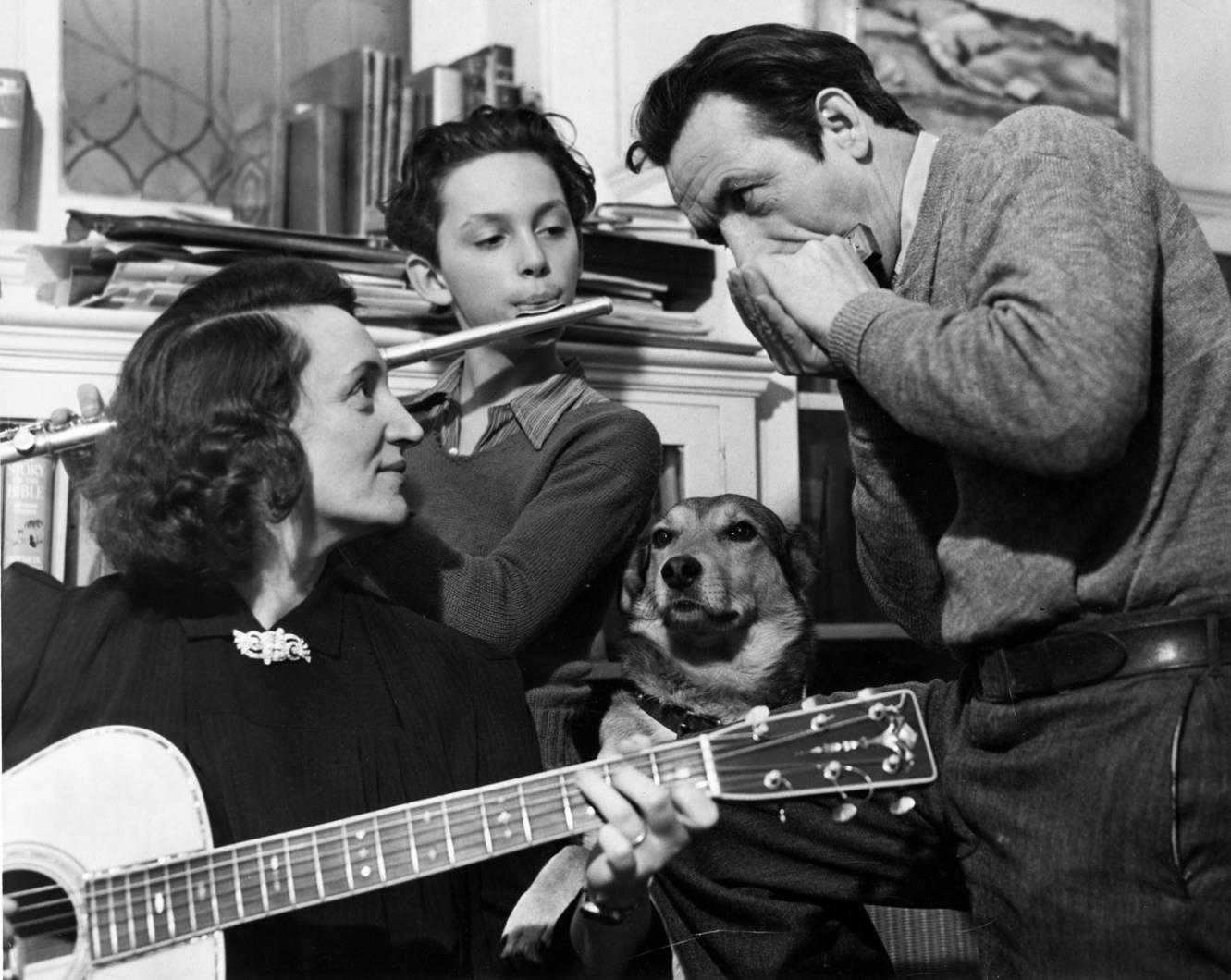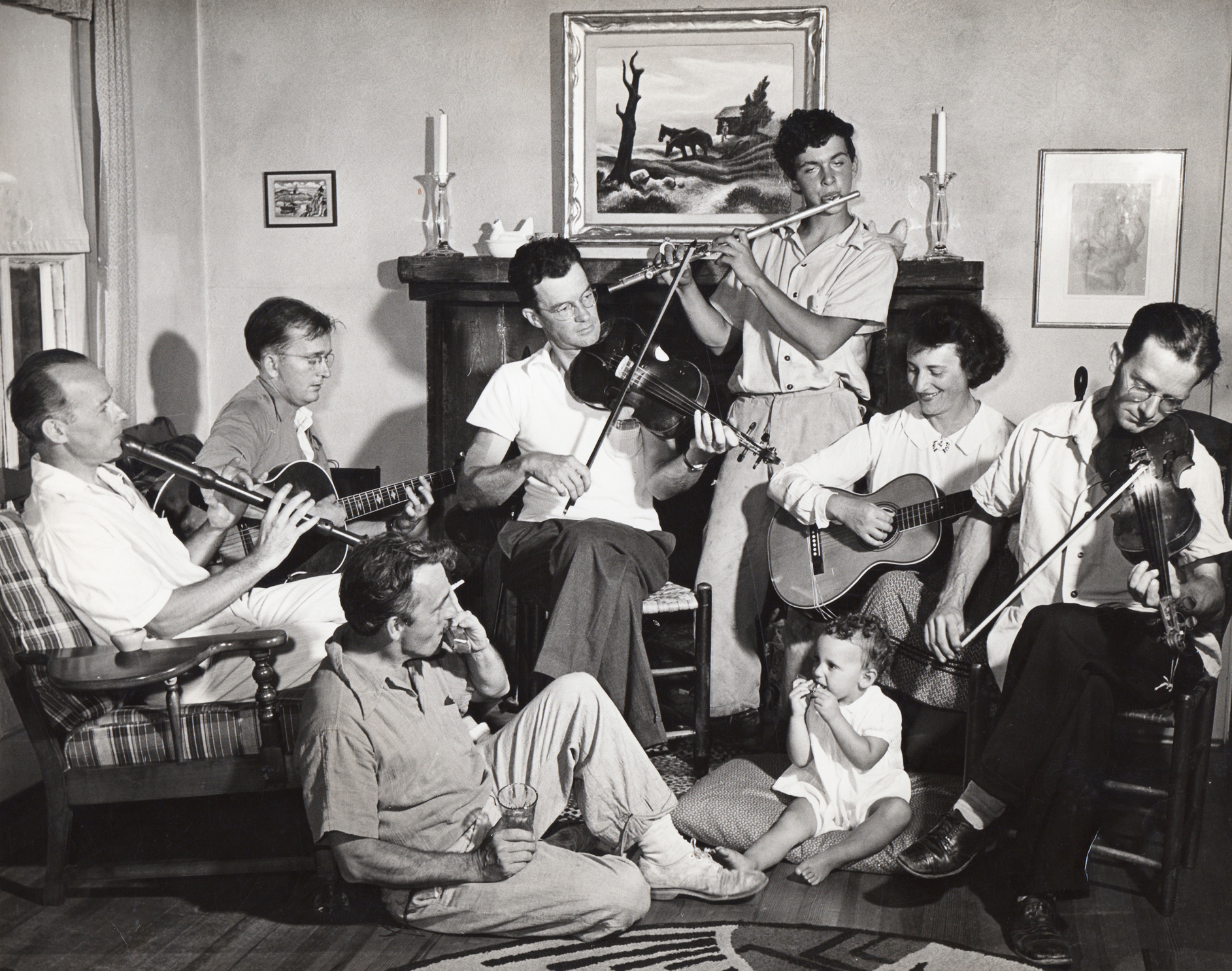Thomas Piacenza Benton, son of the world-renowned artist Thomas Hart Benton, died at his home in Acton on Feb. 14. T.P., as he was called, was 83. A remarkable musician, T.P. was portrayed in a number of his father’s paintings.
The first child of Tom and Rita Benton, T.P. was born in New York city on Dec. 1, 1926. The Bentons were among the Vineyard’s first full-time seasonal residents, and T.P. spent the summers of his youth in Chilmark. When T.P. was two, Tom painted Rita and T.P., depicting his Italian-born wife and son as a Renaissance madonna and child, with Menemsha Pond in the background.
“We hardly ever put on respectable clothes,” Tom wrote of the Vineyard, “and when our son, T.P., was born, he ran naked over the dunes and was sunburned to the color of mahogany.”
When the Bentons built a little house where Tom’s protégé, Jackson Pollock, could live and paint, “Jack became the boy’s idol and through that our chief baby-sitter.” Mr. Pollock and T.P. were fast friends and companions. According to art historian Henry Adams in the new book Tom and Jack, “Eight-year-old T.P. taught him [Mr. Pollock] to sail.”
During this period in the mid-1930s, Mr. Pollock did a tiny oval painting on board, depicting T.P.’s red-sailed boat on the nearby Menemsha Pond. “The painting captured the magic of sailing as a form of escape, when we can imagine disappearing over the horizon and entering new worlds,” Mr. Adams writes. It was, Tom Benton wrote, “a rowboat with a small centerboard. He rigged this up with a homemade mast and a three-cornered sail and called it the Red Jacket. It was supposed to be a pirate ship.” Every afternoon, T.P. could be seen sailing the pond with his dog, Jake.
“Jake was a good traveler. He sat with T.P. in the back seat of our car on the long trips from Kansas City to the summers on Martha’s Vineyard . . . They loved each other,” Tom wrote in the Gazette. One of his paintings is of T.P. and Jake.
One day, Tom “picked up a child’s harmonica that someone had given his son, T.P., and began to make noises,” according to Henry Adams. Soon he was performing at country dances. As a boy, T.P. played the recorder, and a musician friend of the Bentons wrote a trio for harmonica, recorder and guitar (which Rita played), called the Chilmark Suite, which was later recorded by the family for Decca Records.
Then in 1939, as Benton told the story in his book, An Artist In America: “T.P., now 13, had given up his childhood recorders and was playing the flute. To while away the evenings, I picked up the harmonica again . . . and we worked together on duets, old duets by Samartini, Handel and others by little-known German and Italian composers of the 17th and early 18th centuries.”
During Saturday night musical gatherings at the Benton home in Kansas City, T.P.’s flute teacher, David van Vactor, the conductor of the Kansas City Philharmonic, was soon added to the group. Famed chamber music quartets came to join in the sessions. All of this was great for T.P.’s musical education and his flute playing. “He had a chance to play with fine musicians and improve his knowledge and his style,” Tom Benton wrote.

In 1942, Decca released a recording called Saturday Night at Tom Benton’s, on which T.P. plays with the American Chamber Music Group, his father on harmonica, Edward Robinson on harpsichord, and the Frank Luther Singers.
T.P. attended the University of Chicago, but was forced to leave at the age of 18 when drafted into the Army during the Second World War. He performed overseas with a military band and later played with Artie Shaw’s band. In 1945, his father portrayed T.P. in a life-sized portrait, The Flute Player.
He attended the Boston Conservatory and in the summer of 1949, the Gazette noted that, “after a highly successful recital this winter in Boston and a chamber music season at Tanglewood,” T.P. came to the Vineyard “to join in the first van Koppenhagen concert of this summer’s series.”
He then joined his family for a trip to Italy and France, where he remained over the winter “for concerts and further studies.” At the Paris Conservatory, T.P. studied with the famed flute player Marcel Moyse, an inspiring teacher who strove to teach his students not just how to play the flute but to make music. Among Moyse’s many students was James Galway.
A summer 1952 story in the Gazette described T.P. having “developed a career as a flute virtuoso that has been watched with interest by Vineyarders.” He returned to join the van Koppenhagen chamber music group for a program of works by Haydn, Mozart and Schubert, performed at the Edgartown Methodist Church.
For several years, T.P. had his own trio of flute, harp and piano, before joining the symphony orchestra of Orlando, Fla., as first flutist.
In 1960, a feature article in the Gazette wrote of T.P’s preparing to launch at Quitsa Pond a boat that he’d built under his father’s studio at Gay Head. T.P.’s boat-building was another subject of a Benton painting. “It is doubtful if a boat of this kind was ever before built on the Vineyard, for it is a very old design . . . this is the lobsterman’s type, shoal of draft and with a centerboard,” popular on the Maine coast in 1889. T.P. had “been working on this boat for a year and a half, having studied the construction and design from a history of boats in building this particular model. He has chopped certain portions of his training in the Island woods, hewing the trees into shape to fit the places for which they were designed and for the rest he has patronized local lumber yards . . . The boat is slightly more than 22 feet long. It is called a ‘Friendship sloop.’”
After T.P. sailed away from the Island that summer, he returned to the Vineyard only for brief visits. He was always a beneficiary of the property at Gay Head left to him in trust by his parents, after their deaths in 1975.
T.P. considered that growing up on the Vineyard gave him a lifelong love of the sea. He was still sailing his Friendship sloop out of Essex through the last summer of his life.
In addition to his accomplishments as a flutist, T.P. was a student of philosophy, was fluent in German and French and spoke conversational Italian. Like his father, for many years he was also a painter, mostly in the difficult medium of pastels. A realist in style, T.P. admired early American artists such as Frederick Jackson Turner and many of his paintings are scenes of Martha’s Vineyard. His sister, Jessie, tells this story: “When we were together last fall, I hadn’t seen any of his art work for about 20 years and I said, ‘Gee, Tom, your paintings are much better.’ He looked at me and said, ‘Of course they’re better! I’ve been practicing for 35 years!’”
T.P. is survived by his sister, Jessie Benton; his nephew, Anthony Benton Gude; and his nieces, Daria Lyman Kew and Cybele Peper.
A memorial service will be held in the spring in Essex.


Comments (6)
Comments
Comment policy »